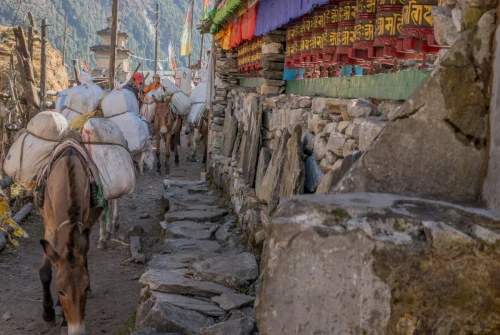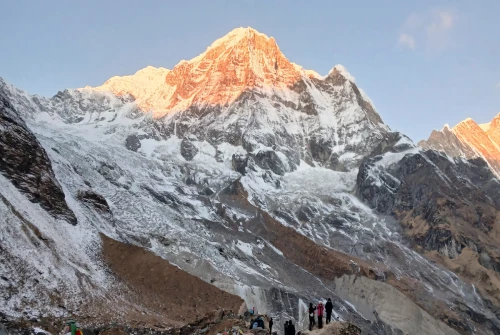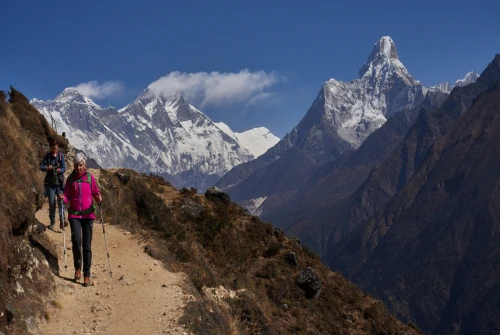Located in the Himalayas between India and China, Nepal is a tiny, landlocked nation. It is renowned for its magnificent natural beauty, enviable culture, and kind inhabitants. Unquestionably, Nepal is one of the most gorgeous nations in the entire globe. Nepal has a lot to offer, from the captivating vistas of the Himalayas to the plethora of natural and historical monuments. After two uncertain and challenging years, Nepal is now completely accessible to tourists and travelers. Nepal offers it everything, from its spectacular sunsets and lofty snow-capped mountains to its outstanding archaeological monuments, magnificent scenic locations, lakes, rivers, art collections, animal reserves, jungle safari, day tours, trekking locations, global packer adventures, and laid-back lifestyle. After being at a halt for two years, the government of Nepal is making a particular effort to encourage tourists to visit Nepal in 2023 by presenting it as a location for luxury, adventure, and everything in between. Here are 15 fantastic reasons to travel to Nepal in 2023, however, you may go there in any year. What are you waiting for, then?
7 Reasons to Visit Nepal in 2026: Adventure, Culture & Nature
Wide variety of wildlife
Nepal's mountains are the main attraction for most travelers, and they truly live up to their reputation. The Nepali Himalayas, the highest mountain range in the world, offer a plethora of adventures and breathtaking views. Whether you plan to trek through them, take a scenic flight, or simply marvel at their presence, the Himalayas in Nepal will leave you in awe. Nepal, often referred to as the "Kingdom of Himalaya," boasts eight out of the ten highest mountains globally, with Mount Everest standing as the pinnacle at 8,848 meters. It is a haven for mountain enthusiasts, offering various activities such as trekking, hiking, mountaineering, and even skiing. With its abundance of trekking routes, Nepal has rightly considered a trekking paradise, catering to all levels of experience, from short and easy trips to extended, challenging adventures in the wilderness. Popular trekking routes like the Everest Base Camp Trek, Annapurna Circuit Trek, and Langtang Valley Trek attract travelers from around the world. The stunning mountain vistas and picturesque landscapes are just a few reasons why Nepal is the ultimate destination for an unforgettable Himalayan experience.
UNESCO World Heritage Sites
Nepal's UNESCO World legacy sites include a diverse spectrum of cultural, religious, and natural treasures that contribute to the country's cultural and natural legacy. With four unique sites, Nepal has a considerable number of UNESCO World Heritage sites. However, it's worth noting that the Kathmandu Valley alone contains seven monument zones, which contribute to the overall total. The following are all of Nepal's UNESCO World Heritage Sites:
- Boudhanath
- Patan Durbar Square
- Swayambhunath
- Changunarayan
- Kathmandu Durbar Square
- Bhaktapur Durbar Square
- Pashupatinath
- Sagarmatha National Park
- Lumbini
- Chitwan National Park
Festivals
Nepal is renowned for its unique culture and lively festivals, in addition to its stunning Himalayan landscapes and abundant natural resources. Despite its small size, this Himalayan nation is home to a diverse population with different cultural backgrounds and traditions, resulting in a rich tapestry of festivities. Many of the festivals celebrated in Nepal hold religious significance, while others are rooted in ancient mythology and epic literature. For travelers who seek a deep understanding of the places they visit, these festivals provide an excellent opportunity to immerse themselves in the local culture and witness the vibrant traditions firsthand.
Diverse Culture
Nepal is a country where a variety of religions are practiced, including Hinduism, Buddhism, Islam, Christianity, Jainism, Sikhism, Bon, ancestor worship, and animism. The majority of Nepalis adhere to either Hinduism or Buddhism, and these two religions have peacefully coexisted for centuries. Buddha is highly revered by both Buddhists and Hindus in Nepal, and Hinduism is the dominant religion with a significant presence of Buddhism, as evidenced by the numerous stupas scattered throughout the country. Additionally, there are smaller populations practicing Kiratism, Islam, and Christianity. This religious diversity and multiculturalism make traveling to different parts of Nepal an enlightening experience, as it allows visitors to learn about the unique customs and traditions of each region.
Wide variety of wildlife
Nepal is an ideal destination for wildlife enthusiasts due to its numerous wildlife reserves. Many people underestimate the abundance of wildlife in Nepal, but they would be mistaken. The lowlands of Nepal offer the opportunity to witness a remarkable array of animal species. The country boasts a diverse population of bird species, and for a more thrilling experience, one can embark on a safari in Chitwan or Bardia National Park to track down crocodiles, rhinos, deer, and the elusive Bengal Tiger. Chitwan National Park, a UNESCO World Heritage site, is particularly renowned for its sightings of Royal Bengal tigers, one-horned rhinos, crocodiles, sloth bears, wild elephants, and an impressive 544 species of birds. Bardia National Park is another pristine wildlife reserve where visitors can observe a wide range of wildlife. In the highlands of Nepal, expect to encounter fascinating creatures such as snow leopards, red pandas, blue sheep, and yaks. From the captivating mountains to the serene wilderness, Nepal offers a diverse range of safari experiences. Therefore, when planning a trip to this beautiful country, ensure you immerse yourself in the awe-inspiring beauty of nature
History
In 1786, King Prithvi Narayan Shah of Gorkha invaded the Kathmandu Valley and unified Nepal, ending the rule of various Kirats, Lichchavis, Thakurs, and Mallas. Prior to this unification, Nepal had a diverse history with different ruling dynasties. The earliest known rulers were the Kirats, who governed Nepal around the 7th century BC. Exploring the history of Nepal can be a compelling reason to visit the country, especially in 2020. Nepal is abundant with ancient archaeological sites, many of which are recognized as UNESCO World Heritage sites. These sites offer a glimpse into the country's rich past and hold significant cultural and historical importance. Local guides can provide captivating stories and insights about these places, keeping visitors enthralled. From the medieval period to the reign of King Birendra Shah, Nepal has a wealth of untold stories that are often unfamiliar to many. For history enthusiasts, Nepal's intriguing history will undoubtedly spark curiosity and deepen their interest in the country.
Great food
The aromas and flavors of Nepali cuisine are distinct and unfamiliar compared to what we are accustomed to. Not everyone may develop a liking for this unique food and its seasonings, but the experience is undoubtedly interesting. Exploring new culinary worlds provides a sense of excitement and novelty, allowing us to imagine ourselves as intrepid explorers of the past. Nepal's cultural diversity, religious practices, and spirit of tolerance are defining characteristics that draw in numerous tourists. Those who claim that Nepali cuisine is just like Indian food have likely not spent enough time in either country. While Nepali cuisine does feature rice and various curries, the ingredients, flavors, and preparation methods differ significantly from Indian curry. Additionally, there are influences from Tibetan cuisines, such as momos and noodle soups, as well as the spicy dishes of the Newari community.




